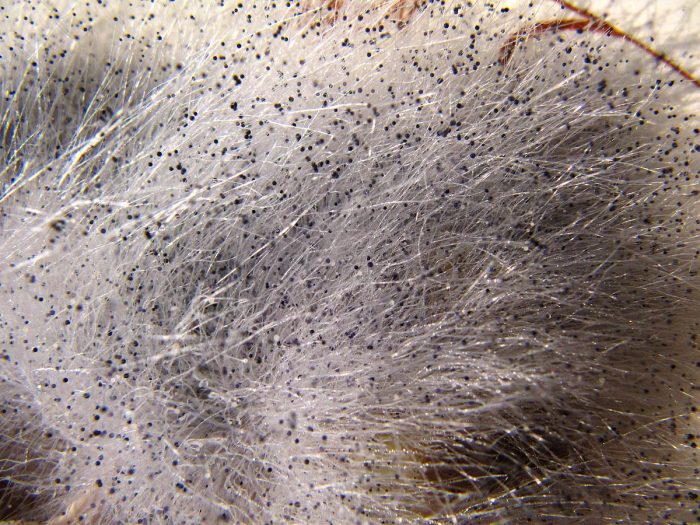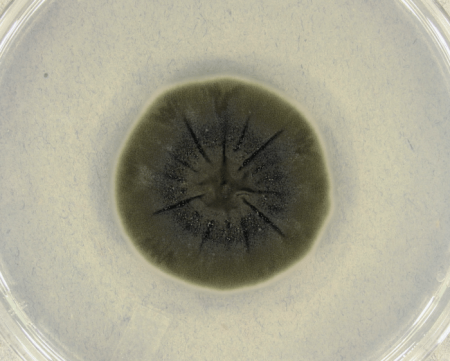
” Bread mold is a type of fungus and is therefore eukaryotic (contains membrane-bound organelles) and multi-cellular. Mold cells are present in a long filamentous structure called a hypha.
The mold cells are connected via pores in the septa between cells and are surrounded by a tube-shaped cell wall. A collection of hyphae is called a mycelium and is a single organism.
How Are Bread Molds Identified?
Molds are typically identified based on their spores and the structures of the parts of the mold that produces the spores. Since the structure of the spore-forming component of the mold can really only be seen using a microscope, the focus here will be on the spores themselves for identifying the type of bread mold.
The easiest way to identify bread mold at home is based on the general appearance of the mold, which is largely attributed to the spores that the mold produces.
There are important observations to make regarding the mold spot when attempting to identify the type of mold growing on your bread:
- Color
- Size/shape
- Texture
What Are The Different Types Of Bread Mold?
-
Rhizopus stolonifer (black bread mold)

“Rhizopus stolonifer4” by WDKeeper via Wikimedia Commons is licensed under CC-BY-SA 4.0 https://creativecommons.org/licenses/by-sa/4.0/deed.en
Rhizopus stolonifer is a common mold that grows on bread; it’s so common that it’s also known as ‘black bread mold’. This mold looks fuzzy on bread, and when it first grows, it tends to appear light in color (either blue, green, or white). Over time, as spores are produced at the ends of aerial hyphae, the mold spot becomes black in color. R. stolonifer grows in circular patches, and will quickly expand over the surface of bread.
-
Penicillium sp.
Penicillium sp. are the other most common types of mold found on breads. It appears as fuzzy patches that are lightly colored, tending to be white, gray, or blue. Penicillium sp. can grow in colder temperatures, and so can be found on bread stored in the refrigerator.
The Pencillium molds, if left to grow, can begin to produce mycotoxins which can ultimately prove to be fatal if consumed regularly or in large quantities.

Image source: Pixabay.

“ladosporium sphaerospermum (UAMH 4745) on potato dextrose agar after incubation for 14 days at 25°C.” by Medmyco via Wikipedia is licensed under CC-BY-SA 4.0
Cladosporium sp. can be identified on bread as large and round mold spots that appear fairly smooth. They tend to be darkly colored, from a dark green to black.
Additionally, Cladosporium mold tends to have a fairly strong odor and is more prone to cause allergic reactions in people with mold allergies.
-
Aspergillus sp.

“Four 3-day old Aspergillus colonies on a Petri dish” by Adrian J. Hunter via Wikipedia. Image licensed under CC-BY-SA 3.0
Aspergillus sp. grows as fuzzy patches on bread, and since many different Aspergillus species can grow on bread, the color of mold spots can be quite varied. Typically, Aspergillus mold spots on bread are yellow or light green in color.
Some strains of Aspergillus molds growing on bread can also produce mycotoxins and should not be consumed.
How Does Mold Form On Bread?
As molds, and fungi in general, are heterotrophs, they are required to consume nutrients in order to obtain the energy needed to function. In order to grow, mold requires nutrients, moisture, air, and an appropriate temperature. The carbohydrates from wheat found in bread are suitable nutrients on which mold can grow, and bread contains the required levels of moisture to support mold growth. If the bread is in an environment with a temperature of greater than 4 °C and has access to the open air, mold can grow.
“If they can make penicillin out of moldy bread, they can sure make something out of you.” — Muhammad Ali
Mold grows on food items such as bread by first coming into contact with the bread as a spore. Mold spores are ubiquitous in the air and float until they come into contact with an object on which they can grow. Once the spore has landed, it colonizes the food item, such as bread, by germinating into a hypha, which spreads out into the bread like a net. The hypha exude digestive enzymes which catabolize nutrients for the mold to absorb.
Is Bread Mold Bad?
Certainly, moldy bread should not be consumed because of the way in which mold grows on bread. As described above, in order to consume nutrients beyond the surface of a food item, molds grow as hyphal filaments that burrow into the food and release digestive enzymes. Therefore, while the moldy spots on bread appear to remain only on the surface, they are actually invisible networks of mold filaments spread throughout the bread. The visible surface portion of the mold is due to the spores formed.
However, the mold that grows on bread is not necessarily bad. The most well-known example of the positive aspects of moldy bread is the discovery of penicillin. Briefly, penicillin is an antibiotic produced by a type of mold that can colonize bread, which allows the mold to defend against bacterial competitors.
How Can Moldy Bread Be Prevented?
Storage
The environment in which bread is stored will have the largest impact on the growth of mold on the bread. Bread should be stored in a dry and cool place. It can be kept in the refrigerator, but that will cause the bread to dry out rapidly and become stale. Instead, store your bread in an airtight container away from heat and moisture. You can also freeze your bread to help keep it fresh. To make this a convenient alternative, slice your bread and freeze it with pieces of wax paper or parchment paper between slices. Place your bread in a freezer bag and ensure that minimal air is trapped in the bag before placing it in the freezer. The bread should last for approximately 6 months in the freezer. Scientists have also been working on storage methods for reducing mold growth on food based on packaging.
Preparation
“The baker’s skill in managing fermentation, not the type of oven used, is what makes good bread.” — Chad Robertson
Home-made tends to have few or no preservative agents added, which allows mold to colonize and grow on the bread more rapidly. You can add some preservatives to your own bread that you bake at home. Some flavoring agents that act as natural preservatives that you could use include garlic, honey, cinnamon, or ginger. You could also add ascorbic acid or lecithin. You can also use sourdough starter as your yeast culture, as the sourdough culture is a mixture of yeast and lactobacilli, and the lactic acid produced by the lactobacilli lowers the pH of the bread, resulting in a reduced ability of molds to colonize the bread.









